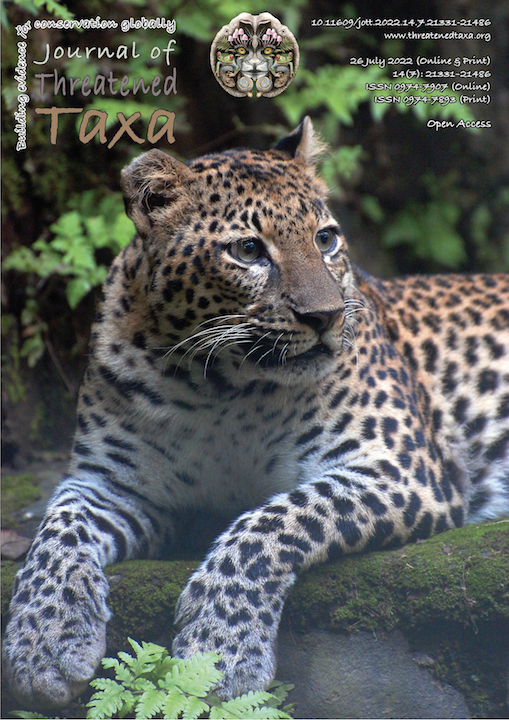A case study on utilization and conservation of threatened plants in Sechu Tuan Nalla Wildlife Sanctuary, western Himalaya, India
Main Article Content
Abstract
During the course of surveys between 2016 and 2019 in the Sechu Tuan Nalla Wildlife Sanctuary, 37 species were reported of which, two critically endangered, 18 endangered, 13 vulnerable, four data deficient and one endemic to western Himalayas were recorded. All the species recorded are highly priced medicinal herbs. It also discussed the sustainable use and conservational approach adopted by the local people dwelling in the vicinity of the protected area for an endangered medicinal plant, Fritillaria cirrhosa D.Don.
Article Details

This work is licensed under a Creative Commons Attribution 4.0 International License.
Authors own the copyright to the articles published in JoTT. This is indicated explicitly in each publication. The authors grant permission to the publisher Wildlife Information Liaison Development (WILD) Society to publish the article in the Journal of Threatened Taxa. The authors recognize WILD as the original publisher, and to sell hard copies of the Journal and article to any buyer. JoTT is registered under the Creative Commons Attribution 4.0 International License (CC BY), which allows authors to retain copyright ownership. Under this license the authors allow anyone to download, cite, use the data, modify, reprint, copy and distribute provided the authors and source of publication are credited through appropriate citations (e.g., Son et al. (2016). Bats (Mammalia: Chiroptera) of the southeastern Truong Son Mountains, Quang Ngai Province, Vietnam. Journal of Threatened Taxa 8(7): 8953–8969. https://doi.org/10.11609/jott.2785.8.7.8953-8969). Users of the data do not require specific permission from the authors or the publisher.
References
Badola, H.K. & J.S. Butola (2004). Threatened medicinal plant cultivation succeeds in Himachal Himalaya. Biological Conservation Newsletter 229:1.
Bisht, V.K., J.S. Negi & A.K. Bhandari (2016). Check on extinction of medicinal herbs in Uttarakhand: No need to uproot. National Academy Science Letters 39: 233–235. DOI: https://doi.org/10.1007/s40009-016-0437-1
Chauhan, R.S., M.C. Nautiyal, R.K. Vashistha, P. Prasad, A.R. Nautiya, A. Kumar & J.A.T. da Silva (2011). Morpho-biochemical variability and selection strategies for the germplasm of Fritillaria roylei Hook. (Liliaceae)-an endangered medicinal herb of Western Himalaya. Indian Journal of Plant Breeding and Crop Science 3: 430–434. DOI: https://doi.org/10.5897/JPBCS11.081
GOI (2016). Draft of the notification, serial number 13 for Ministry of Environment Forests & Climate Change, Published on 6th July, 2016 by Directorate of Printing, Department of Publication M/o Housing and Urban Affairs, Government of India. http://egazette.nic.in/. Accessed on 16th October, 2020.
IUCN (2001). IUCN Red List Categories and Criteria, Version 3.1. International Union for Conservation of Nature and Natural Resources, Gland, Switzerland, 30p.
Jain, S.K. & A.R.K. Sastry (Eds.) (1980). Threatened Plants of India. A State-of-the Art Report. Botanical Survey of India, Kolkata, India, 27p.
Jain, S.K. & A.R.K. Sastry (Eds.) (1984). The Indian Plant Red Data Book -1, Botanical Survey of India, Kolkata, India.
Mashizi, K.A. & M. Sharafatmandrad (2020). Assessing ecological success and social acceptance of protected areas in semiarid ecosystems: A socio-ecological case study of Khabr National Park, Iran. Journal for Nature Conservation 57: 125898. https://doi.org/10.1016/j.jnc.2020.125898 DOI: https://doi.org/10.1016/j.jnc.2020.125898
Kirtikar, K.R. & B.D. Basu (1984). Indian Medicinal Plants: Bishen Singh Mahendra Pal Singh, Dehradun, Uttarakhand, India, 766pp.
Kumar, G.P., R. Kumar, O.P. Chaurasia & S.B. Singh (2011). Current status and potential prospects of medicinal plant sector in trans-Himalayan Ladakh. Journal of Medicinal Plants Research 5: 2929–2940. DOI: https://doi.org/10.3923/rjmp.2011.685.694
Kuniyal, C.P., V.K. Bisht, J.S. Negi, V.P. Bhatt, D.S. Bisht, J. Butola, R. Sundriyal & S. Singh (2015). Progress and prospect in the integrated development of Medicinal and Aromatic Plants (MAPs) sector in Uttarakhand, Western Himalaya. Environment, Development and Sustainability 17: 1141–1162. DOI: https://doi.org/10.1007/s10668-014-9595-9
Margules, C. & R. Pressey (2000). Systematic conservation planning. Nature 405: 243–253. DOI: https://doi.org/10.1038/35012251
Nayar, M.P. & A.R.K. Sastry (eds.) (1987). Red Data Book of Indian Plants. Vol. 1. Botanical Survey of India, Kolkata, India, 367 pp.
Nayar, M.P. & A.R.K. Sastry (eds.) (1988). Red Data Book of Indian Plants. Vol. 2. Botanical Survey of India, Kolkata, India, 268 pp.
Nayar, M.P. & A.R.K. Sastry (eds.) (1990). Red Data Book of Indian Plants. Vol. 3. Botanical Survey of India, Kolkata, India, 271 pp.
Piccolo, J.J. (2017). Intrinsic values in nature: Objective good or simply half of an unhelpful dichotomy? Journal of Nature Conservation 37: 8–11. DOI: https://doi.org/10.1016/j.jnc.2017.02.007
Rana, M.S. & S.S. Samant (2010). Threat categorization and conservation prioritization of floristic diversity in the Indian Himalayan Region-a state of art approach from Manali Wildlife Sanctuary. Journal for Nature Conservation 18: 159–168. DOI: https://doi.org/10.1016/j.jnc.2009.08.004
Rao, K.C., B.L. Geetha & S. Geetha (2003). Red List of Threatened Vascular Plant Species in India. Botanical Survey of India, ENVIS Centre for Floral Diversity, Howrah, West Bengal, India, 144 pp.
Rawat, G.S. (2005). Alpine Meadows of Uttaranchal: Ecology, Land use, and Status of Medicinal and Aromatic Plants. Bishen Pal Singh Mahendra Pal Singh, Dehradun, Uttarakhand, India, 219 pp.
Ved, D.K., G.A. Kinhal, K. Ravikumar, V. Prabhakaran, U. Ghate, R.V. Sankar & J.H. Indresha (2003). CAMP Workshop Report: Conservation Assessment and Management Prioritization for the Medicinal Plants of J & K, H.P. & Uttaranchal, Shimla, H.P. FRLHT, Bangalore, India, 206pp.

